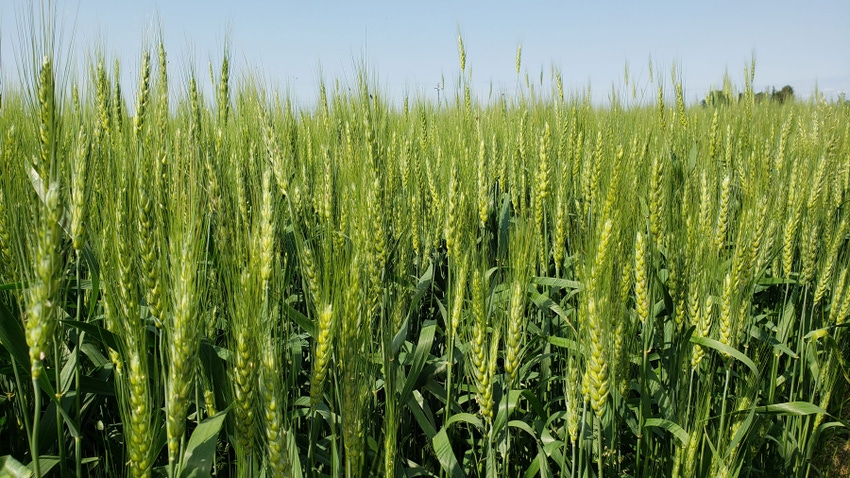February 7, 2023

by Dwight Lingenfelter
As populations of winter annual weeds become more prevalent in March and April, they compete with wheat by slowing the rate of crop development, thus potentially reducing yield.
Harmony Extra — or any other product that contains thifensulfuron and tribenuron — is still a commonly used herbicide for broadleaf control. Clarity/dicamba, 2,4-D, MCPA or Finesse can improve the control of some winter annuals and perennials while Stinger is the most effective small grain herbicide for thistles.
Here are some best bets for common problem weeds in the spring:
Common chickweed. Harmony Extra and Quelex are still effective in many parts of the region. However, there are pockets of resistant populations starting to thrive. Tank-mix with Metricor (metribuzin) or Starane Ultra if ALS-resistant chickweed is prevalent.
Marestail. Products such as 2,4-D, dicamba, Huskie, Quelex and Stinger applied postemergence have activity on this weed.
Speedwell. There are several speedwell (Veronica) species, including corn, common, ivyleaf and others, and many of the commonly used small grain herbicides are not effective. Harmony Extra, plus Quelex or Starane Ultra, has provided control of ivyleaf speedwell.
PowerFlex HL, Metricor or Aim provides some activity of certain speedwell species when small. Finesse has certain speedwells listed on its label and usually provides about 80% control. Be cautious of crop rotation intervals if using Finesse.
Downy brome. Herbicide options include Finesse, Osprey and PowerFlex HL.
Annual ryegrass. Osprey and PowerFlex HL tend to be the most consistent, while Finesse has activity on this weed, and Axial is effective if the population is not Group 1 resistant.
Annual bluegrass. Active herbicides include Metricor, Finesse and Osprey.
Roughstalk bluegrass. Studies at Michigan State show that Osprey, Axial XL/Bold and PowerFlex HL provide control of this weed. However, Osprey applied to roughstalk bluegrass at 1-2 inches tall in the fall or early spring provided the most consistent control.
Fall treatments provide effective initial control — greater than 90% ��— from these products, but spring emergence of roughstalk bluegrass leads to escapes by harvest. Late-spring applications are usually not as effective since the weed is too tall at that point.
Remember that cool — less than 50 degrees F — cloudy days can reduce herbicide activity. Applications this early are not likely to effectively control dandelions or Canada thistle. These weeds would be more effectively controlled with a later spring application.
Liquid fertilizer carriers, herbicides
Liquid urea-ammonium nitrate fertilizer (UAN) is a common spray solution carrier for herbicides in wheat in our region.
We typically recommend no more than a 50-50 water-UAN ratio. The most common herbicide used in this manner is 2,4-D ester at 1 pint per acre.
Application of herbicide in liquid nitrogen can cause leaf burn from the nitrogen, especially under hot, humid conditions, and the addition of other herbicides or fungicides to these mixtures will likely increase the risk for crop injury. This risk increases with later wheat growth because more leaf area is exposed to the treatment and recovery time is shorter.
Applications of 2,4-D should be made in spring to actively growing wheat following tillering (Feeke’s 3) but before jointing (Feeke’s 6). To minimize risk:
• Do not apply more than 20 pounds nitrogen per acre in the form of UAN when using a surfactant with herbicide.
• Do not apply more than 40 pounds of nitrogen per acre in the form of UAN when no surfactant is used.
• Avoid high-temperature, high-humidity days. Late-afternoon applications carry less risk of leaf burn.
Below are the specific adjuvant recommendations for Harmony SG and Harmony Extra SG:

Herbicides like Osprey, PowerFlex HL and Quelex can be applied in a UAN carrier, but certain guidelines must be followed, and temporary crop injury may occur:
Osprey. Fertilizer spray solution should not exceed 15% liquid nitrogen — 1.5 gallons of liquid nitrogen in 10 gallons of spray solution per acre — and it must include NIS of 0.25% volume per volume — 1 quart per 100 gallons of spray solution.
PowerFlex HL. Carrier should not be composed of more than 50% liquid nitrogen fertilizer and should not exceed 30 pounds actual nitrogen per acre. Use NIS at a maximum of 0.25% volume per volume instead of crop oil concentrate.
Quelex. Spray solutions containing liquid nitrogen fertilizer can be used. If NIS is included, use a maximum rate of 0.25% volume per volume. Do not use crop oil concentrate or methylated seed oil.Additional adjuvants are not needed if tank-mixing with 2,4-D ester or MCPA ester, and liquid nitrogen fertilizer.
Metribuzin. Application via liquid nitrogen fertilizer carrier is typically not recommended.
Aside from these products, other herbicides may allow the use of liquid nitrogen fertilizer as a carrier, but make sure to review the product label for details.
Lingenfelter is an Extension associate of weed science with Penn State Cooperative Extension.
You May Also Like




